Research Report: Gender Equality in the Workplace at Tesco Plc
VerifiedAdded on 2022/08/20
|25
|5688
|16
Report
AI Summary
This report undertakes a comprehensive analysis of gender equality within the workplace, with a specific focus on Tesco Plc. The research explores various aspects of gender inequality, including pay gaps, underrepresentation of female employees in management, and the overall impact of gender equality on organizational productivity and growth. The study incorporates both primary and secondary data, utilizing Tesco Plc's annual reports, performance information, and website content. The methodology includes a literature review, exploratory and descriptive research approaches, and qualitative and quantitative data analysis. Primary data collection involves semi-structured interviews with senior management employees. The report aims to identify variations between male and female employees, investigate the correlation between gender equality and firm growth, and assess the impact of gender equality on productivity. The conclusion and recommendations offer insights into fostering a more equitable and inclusive workplace environment, alongside a personal reflective statement discussing the research methods employed and potential areas for future research. The report highlights the importance of leadership, cultural change, and inclusive practices in achieving gender equality within the organization.
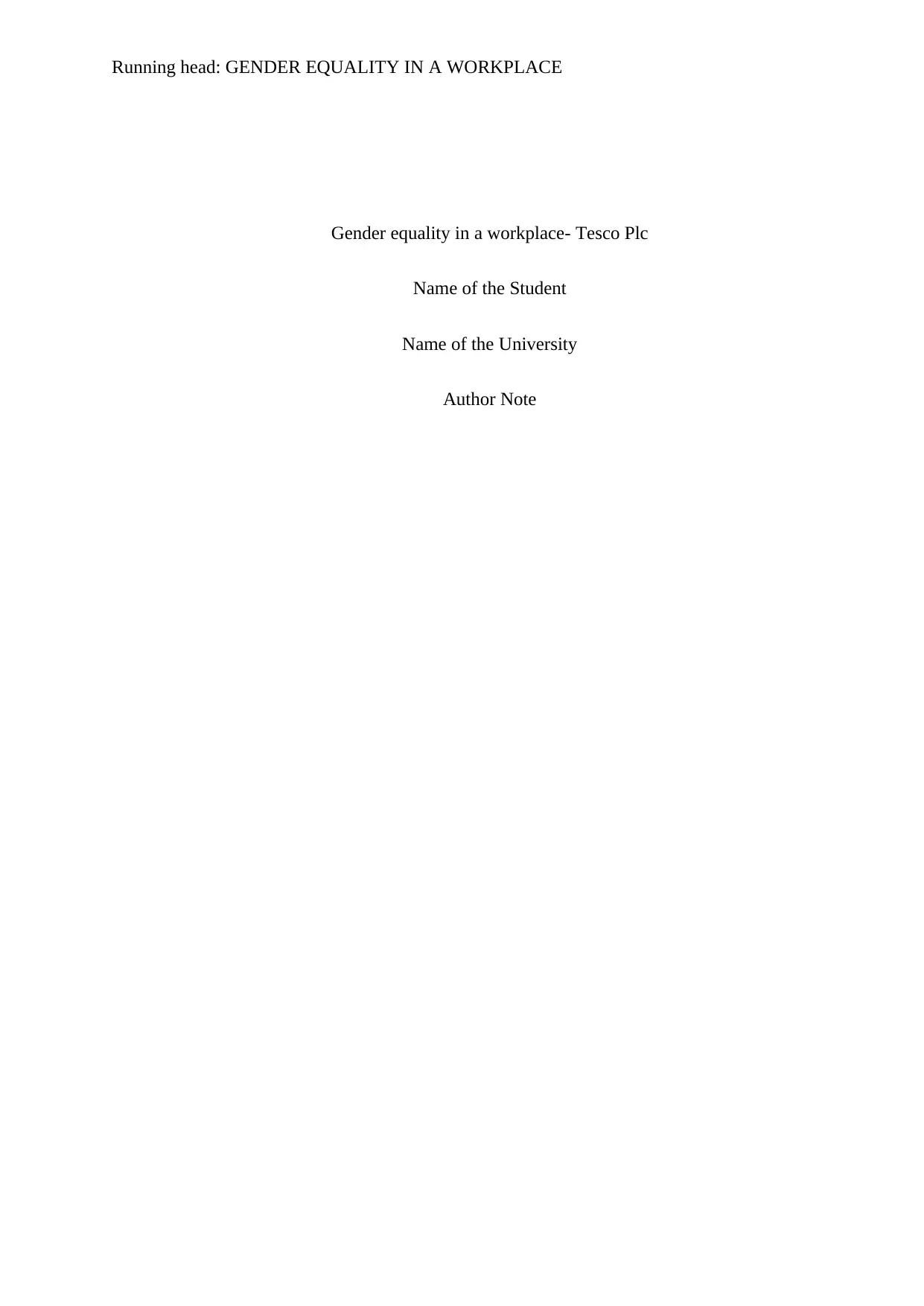
Running head: GENDER EQUALITY IN A WORKPLACE
Gender equality in a workplace- Tesco Plc
Name of the Student
Name of the University
Author Note
Gender equality in a workplace- Tesco Plc
Name of the Student
Name of the University
Author Note
Paraphrase This Document
Need a fresh take? Get an instant paraphrase of this document with our AI Paraphraser

GENDER EQUALITY IN A WORKPLACE
Table of Contents
Chapter 1: Introduction..............................................................................................................4
1.1 Research proposal................................................................................................................4
i) Description of research project...............................................................................................4
ii) Research aims and objectives................................................................................................4
iii) Research for choosing this research project.........................................................................5
iv) Activities and timescales......................................................................................................5
Chapter 2: Literature review......................................................................................................6
2.1 Introduction:.........................................................................................................................6
2.2 Literature review..................................................................................................................6
Chapter 3: Methodology..........................................................................................................10
3.1 Research approach.............................................................................................................10
3.2 Research methodologies.....................................................................................................10
i) Sampling...........................................................................................................................11
ii) Data analysis........................................................................................................................11
iii) Cost, access and ethical considerations..............................................................................12
Chapter 4: Data collection and analysis...................................................................................12
4.1 Data collection...................................................................................................................12
4.2 Data analysis, presentation and discussion........................................................................13
Chapter 5: Conclusion and recommendation...........................................................................14
5.1 Conclusions........................................................................................................................14
5.2 Recommendations..............................................................................................................14
Table of Contents
Chapter 1: Introduction..............................................................................................................4
1.1 Research proposal................................................................................................................4
i) Description of research project...............................................................................................4
ii) Research aims and objectives................................................................................................4
iii) Research for choosing this research project.........................................................................5
iv) Activities and timescales......................................................................................................5
Chapter 2: Literature review......................................................................................................6
2.1 Introduction:.........................................................................................................................6
2.2 Literature review..................................................................................................................6
Chapter 3: Methodology..........................................................................................................10
3.1 Research approach.............................................................................................................10
3.2 Research methodologies.....................................................................................................10
i) Sampling...........................................................................................................................11
ii) Data analysis........................................................................................................................11
iii) Cost, access and ethical considerations..............................................................................12
Chapter 4: Data collection and analysis...................................................................................12
4.1 Data collection...................................................................................................................12
4.2 Data analysis, presentation and discussion........................................................................13
Chapter 5: Conclusion and recommendation...........................................................................14
5.1 Conclusions........................................................................................................................14
5.2 Recommendations..............................................................................................................14
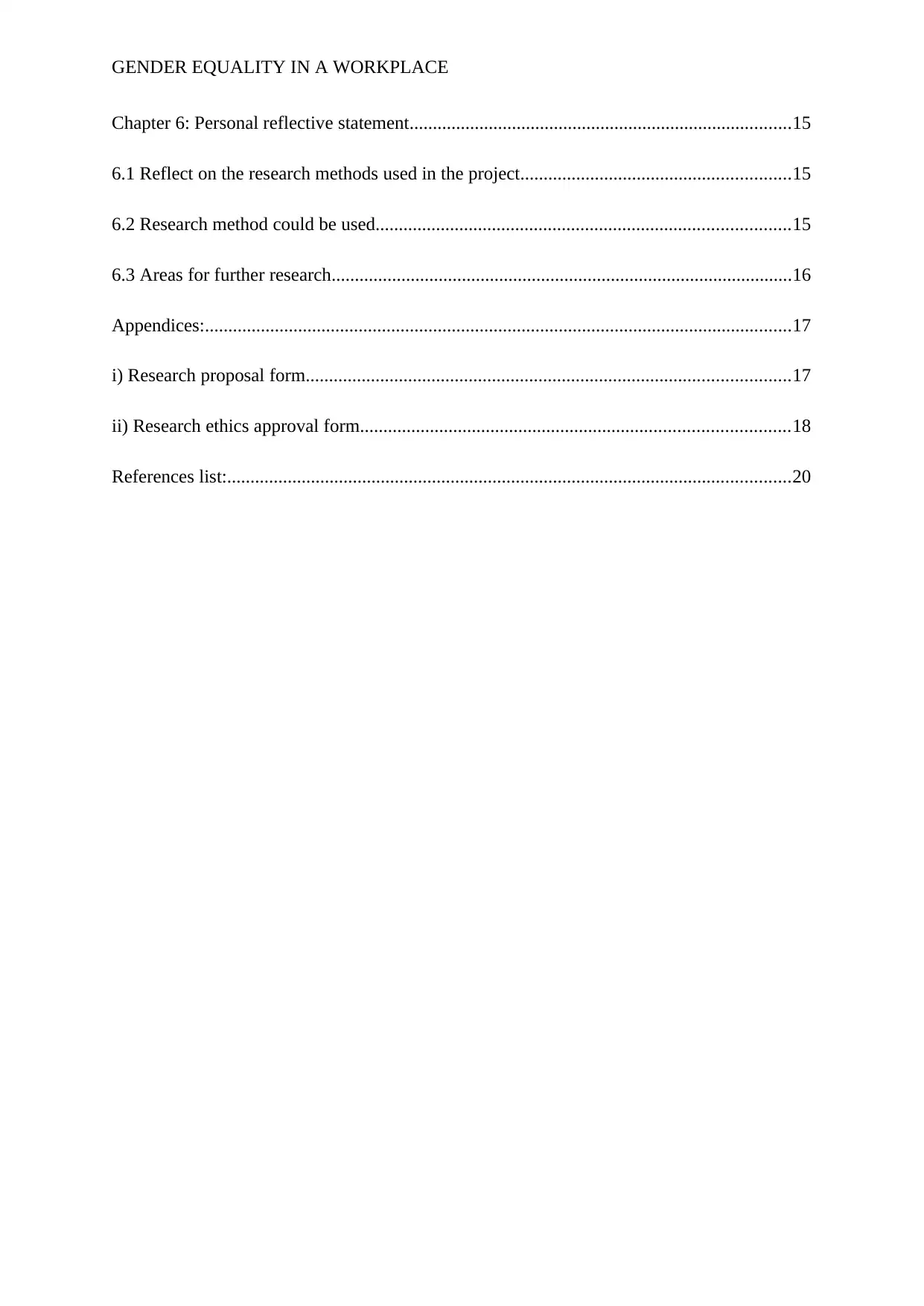
GENDER EQUALITY IN A WORKPLACE
Chapter 6: Personal reflective statement..................................................................................15
6.1 Reflect on the research methods used in the project..........................................................15
6.2 Research method could be used.........................................................................................15
6.3 Areas for further research...................................................................................................16
Appendices:..............................................................................................................................17
i) Research proposal form........................................................................................................17
ii) Research ethics approval form............................................................................................18
References list:.........................................................................................................................20
Chapter 6: Personal reflective statement..................................................................................15
6.1 Reflect on the research methods used in the project..........................................................15
6.2 Research method could be used.........................................................................................15
6.3 Areas for further research...................................................................................................16
Appendices:..............................................................................................................................17
i) Research proposal form........................................................................................................17
ii) Research ethics approval form............................................................................................18
References list:.........................................................................................................................20
⊘ This is a preview!⊘
Do you want full access?
Subscribe today to unlock all pages.

Trusted by 1+ million students worldwide
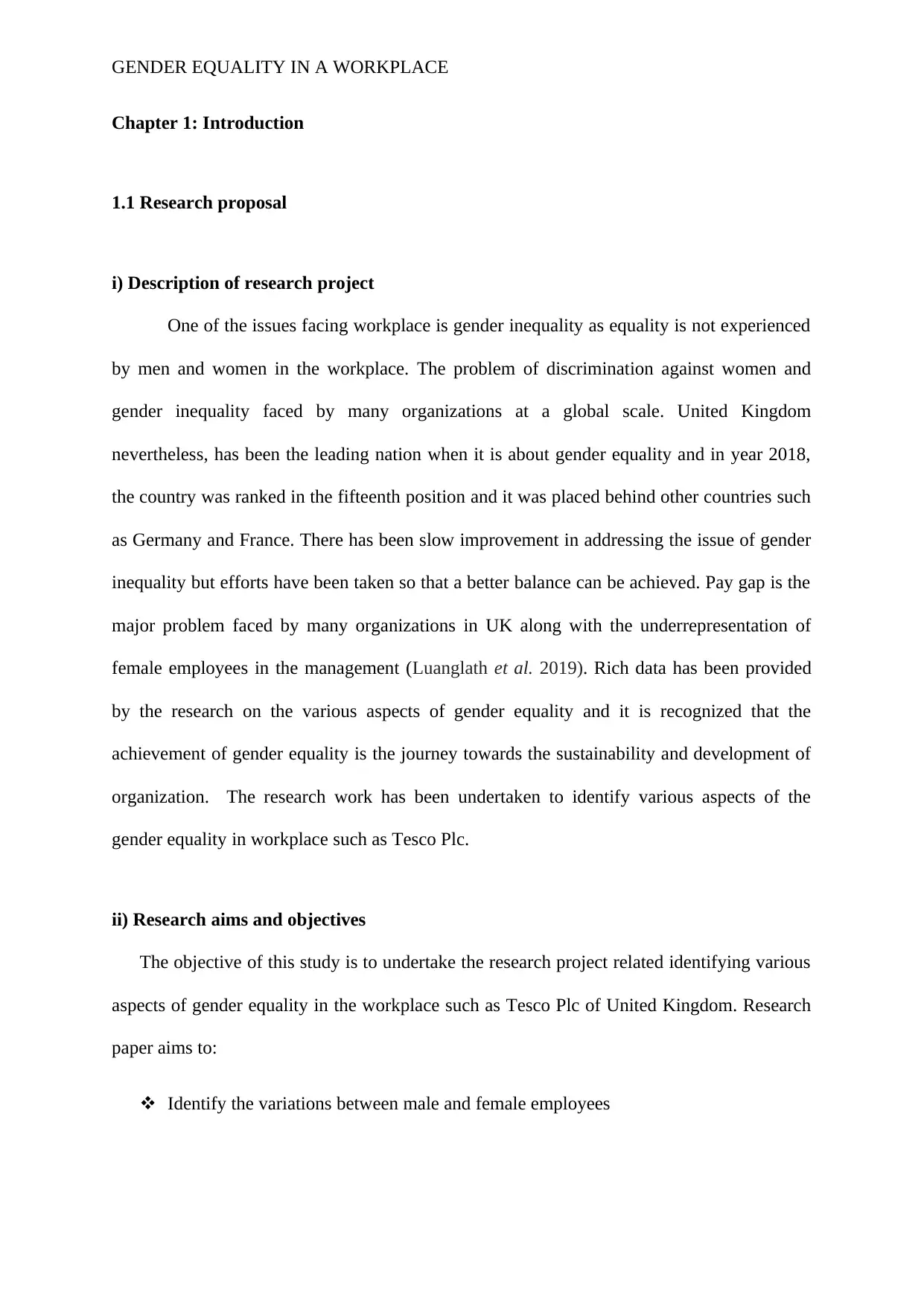
GENDER EQUALITY IN A WORKPLACE
Chapter 1: Introduction
1.1 Research proposal
i) Description of research project
One of the issues facing workplace is gender inequality as equality is not experienced
by men and women in the workplace. The problem of discrimination against women and
gender inequality faced by many organizations at a global scale. United Kingdom
nevertheless, has been the leading nation when it is about gender equality and in year 2018,
the country was ranked in the fifteenth position and it was placed behind other countries such
as Germany and France. There has been slow improvement in addressing the issue of gender
inequality but efforts have been taken so that a better balance can be achieved. Pay gap is the
major problem faced by many organizations in UK along with the underrepresentation of
female employees in the management (Luanglath et al. 2019). Rich data has been provided
by the research on the various aspects of gender equality and it is recognized that the
achievement of gender equality is the journey towards the sustainability and development of
organization. The research work has been undertaken to identify various aspects of the
gender equality in workplace such as Tesco Plc.
ii) Research aims and objectives
The objective of this study is to undertake the research project related identifying various
aspects of gender equality in the workplace such as Tesco Plc of United Kingdom. Research
paper aims to:
Identify the variations between male and female employees
Chapter 1: Introduction
1.1 Research proposal
i) Description of research project
One of the issues facing workplace is gender inequality as equality is not experienced
by men and women in the workplace. The problem of discrimination against women and
gender inequality faced by many organizations at a global scale. United Kingdom
nevertheless, has been the leading nation when it is about gender equality and in year 2018,
the country was ranked in the fifteenth position and it was placed behind other countries such
as Germany and France. There has been slow improvement in addressing the issue of gender
inequality but efforts have been taken so that a better balance can be achieved. Pay gap is the
major problem faced by many organizations in UK along with the underrepresentation of
female employees in the management (Luanglath et al. 2019). Rich data has been provided
by the research on the various aspects of gender equality and it is recognized that the
achievement of gender equality is the journey towards the sustainability and development of
organization. The research work has been undertaken to identify various aspects of the
gender equality in workplace such as Tesco Plc.
ii) Research aims and objectives
The objective of this study is to undertake the research project related identifying various
aspects of gender equality in the workplace such as Tesco Plc of United Kingdom. Research
paper aims to:
Identify the variations between male and female employees
Paraphrase This Document
Need a fresh take? Get an instant paraphrase of this document with our AI Paraphraser

GENDER EQUALITY IN A WORKPLACE
Is there any correlation between the gender equality and growth of the firm such as
Tesco Plc?
Does the productivity of Tesco Plc is impacted by gender equality?
iii) Research for choosing this research project
The research work on identifying the gender equality and its different aspects in the
working of organization such as Tesco Plc has been undertaken because of various reasons.
Firstly, one of the most interesting aspects of the gender equality has been witnessed by UK.
The equalities Act has been made legal for the large section of employers. In this regard, it is
required by them to report on the gender pay gap. Secondly, the right of women to the vote in
1918 has been celebrated by the country. In addition to this, there also exist a challenge of
diversity in the workplace at different position. This made the research work on the gender
equality quite essential.
iv) Activities and timescales
Research project is undertaken by reviewing the literature and secondary research
paper that forms the basis of arguments presented in the study. An appropriate methodology
would be employed along with the proper statistical tool for analysing the data. The present
study is undertaken to conduct an investigation into the gender equality in the workplace such
as Tesco Plc by analysing its annual report, report on the performance information and
websites of company.
Main activity 1st week 2nd week 3rd and 4th
week
5th and 6th
week
7th week
Topic selection
Research
objectives and
Is there any correlation between the gender equality and growth of the firm such as
Tesco Plc?
Does the productivity of Tesco Plc is impacted by gender equality?
iii) Research for choosing this research project
The research work on identifying the gender equality and its different aspects in the
working of organization such as Tesco Plc has been undertaken because of various reasons.
Firstly, one of the most interesting aspects of the gender equality has been witnessed by UK.
The equalities Act has been made legal for the large section of employers. In this regard, it is
required by them to report on the gender pay gap. Secondly, the right of women to the vote in
1918 has been celebrated by the country. In addition to this, there also exist a challenge of
diversity in the workplace at different position. This made the research work on the gender
equality quite essential.
iv) Activities and timescales
Research project is undertaken by reviewing the literature and secondary research
paper that forms the basis of arguments presented in the study. An appropriate methodology
would be employed along with the proper statistical tool for analysing the data. The present
study is undertaken to conduct an investigation into the gender equality in the workplace such
as Tesco Plc by analysing its annual report, report on the performance information and
websites of company.
Main activity 1st week 2nd week 3rd and 4th
week
5th and 6th
week
7th week
Topic selection
Research
objectives and

GENDER EQUALITY IN A WORKPLACE
aims
determination
Reviewing
literature using
different sources
Suitable
research
technique
selection
Data collection
and analysis
Conclusion and
recommendation
Chapter 2: Literature review
2.1 Introduction:
The persistent neglecting the gender flexibility and gender equality has been
confirmed by the literature particularly in the private sector. Gaps has been identified by
much of the work on gender equality between the use and provision of flexible work
arrangements. It is a growing evidence from literature that there might be unintended impact
on the gender equality because of provisioning various types of flexible working practices. It
has been founded by many scholars that an ad hoc approach on the diversity and equality is
adopted by most of the organizations in general (Ozturk and Tatli 2016).
2.2 Literature review
Issues facing gender equality:
aims
determination
Reviewing
literature using
different sources
Suitable
research
technique
selection
Data collection
and analysis
Conclusion and
recommendation
Chapter 2: Literature review
2.1 Introduction:
The persistent neglecting the gender flexibility and gender equality has been
confirmed by the literature particularly in the private sector. Gaps has been identified by
much of the work on gender equality between the use and provision of flexible work
arrangements. It is a growing evidence from literature that there might be unintended impact
on the gender equality because of provisioning various types of flexible working practices. It
has been founded by many scholars that an ad hoc approach on the diversity and equality is
adopted by most of the organizations in general (Ozturk and Tatli 2016).
2.2 Literature review
Issues facing gender equality:
⊘ This is a preview!⊘
Do you want full access?
Subscribe today to unlock all pages.

Trusted by 1+ million students worldwide
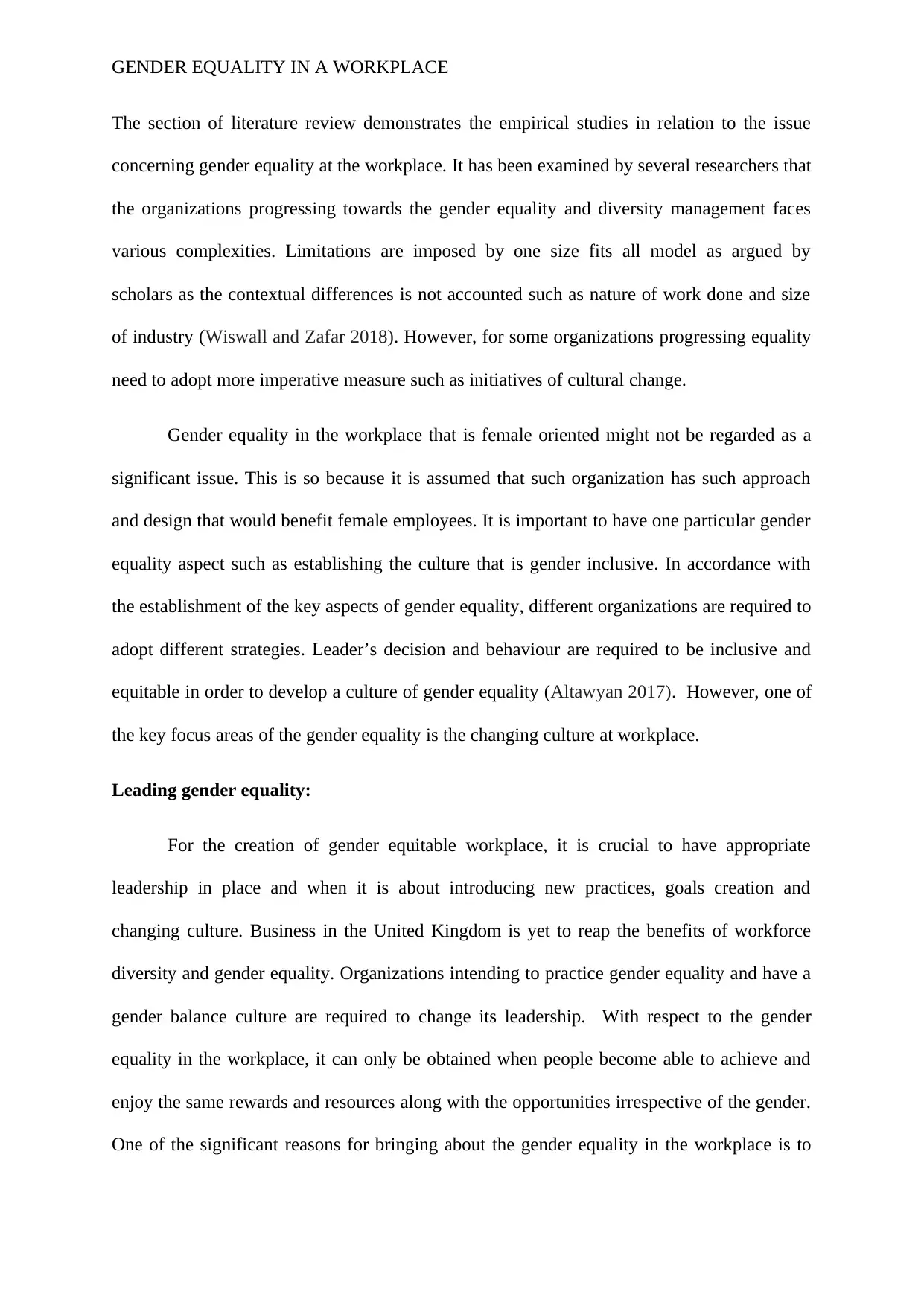
GENDER EQUALITY IN A WORKPLACE
The section of literature review demonstrates the empirical studies in relation to the issue
concerning gender equality at the workplace. It has been examined by several researchers that
the organizations progressing towards the gender equality and diversity management faces
various complexities. Limitations are imposed by one size fits all model as argued by
scholars as the contextual differences is not accounted such as nature of work done and size
of industry (Wiswall and Zafar 2018). However, for some organizations progressing equality
need to adopt more imperative measure such as initiatives of cultural change.
Gender equality in the workplace that is female oriented might not be regarded as a
significant issue. This is so because it is assumed that such organization has such approach
and design that would benefit female employees. It is important to have one particular gender
equality aspect such as establishing the culture that is gender inclusive. In accordance with
the establishment of the key aspects of gender equality, different organizations are required to
adopt different strategies. Leader’s decision and behaviour are required to be inclusive and
equitable in order to develop a culture of gender equality (Altawyan 2017). However, one of
the key focus areas of the gender equality is the changing culture at workplace.
Leading gender equality:
For the creation of gender equitable workplace, it is crucial to have appropriate
leadership in place and when it is about introducing new practices, goals creation and
changing culture. Business in the United Kingdom is yet to reap the benefits of workforce
diversity and gender equality. Organizations intending to practice gender equality and have a
gender balance culture are required to change its leadership. With respect to the gender
equality in the workplace, it can only be obtained when people become able to achieve and
enjoy the same rewards and resources along with the opportunities irrespective of the gender.
One of the significant reasons for bringing about the gender equality in the workplace is to
The section of literature review demonstrates the empirical studies in relation to the issue
concerning gender equality at the workplace. It has been examined by several researchers that
the organizations progressing towards the gender equality and diversity management faces
various complexities. Limitations are imposed by one size fits all model as argued by
scholars as the contextual differences is not accounted such as nature of work done and size
of industry (Wiswall and Zafar 2018). However, for some organizations progressing equality
need to adopt more imperative measure such as initiatives of cultural change.
Gender equality in the workplace that is female oriented might not be regarded as a
significant issue. This is so because it is assumed that such organization has such approach
and design that would benefit female employees. It is important to have one particular gender
equality aspect such as establishing the culture that is gender inclusive. In accordance with
the establishment of the key aspects of gender equality, different organizations are required to
adopt different strategies. Leader’s decision and behaviour are required to be inclusive and
equitable in order to develop a culture of gender equality (Altawyan 2017). However, one of
the key focus areas of the gender equality is the changing culture at workplace.
Leading gender equality:
For the creation of gender equitable workplace, it is crucial to have appropriate
leadership in place and when it is about introducing new practices, goals creation and
changing culture. Business in the United Kingdom is yet to reap the benefits of workforce
diversity and gender equality. Organizations intending to practice gender equality and have a
gender balance culture are required to change its leadership. With respect to the gender
equality in the workplace, it can only be obtained when people become able to achieve and
enjoy the same rewards and resources along with the opportunities irrespective of the gender.
One of the significant reasons for bringing about the gender equality in the workplace is to
Paraphrase This Document
Need a fresh take? Get an instant paraphrase of this document with our AI Paraphraser
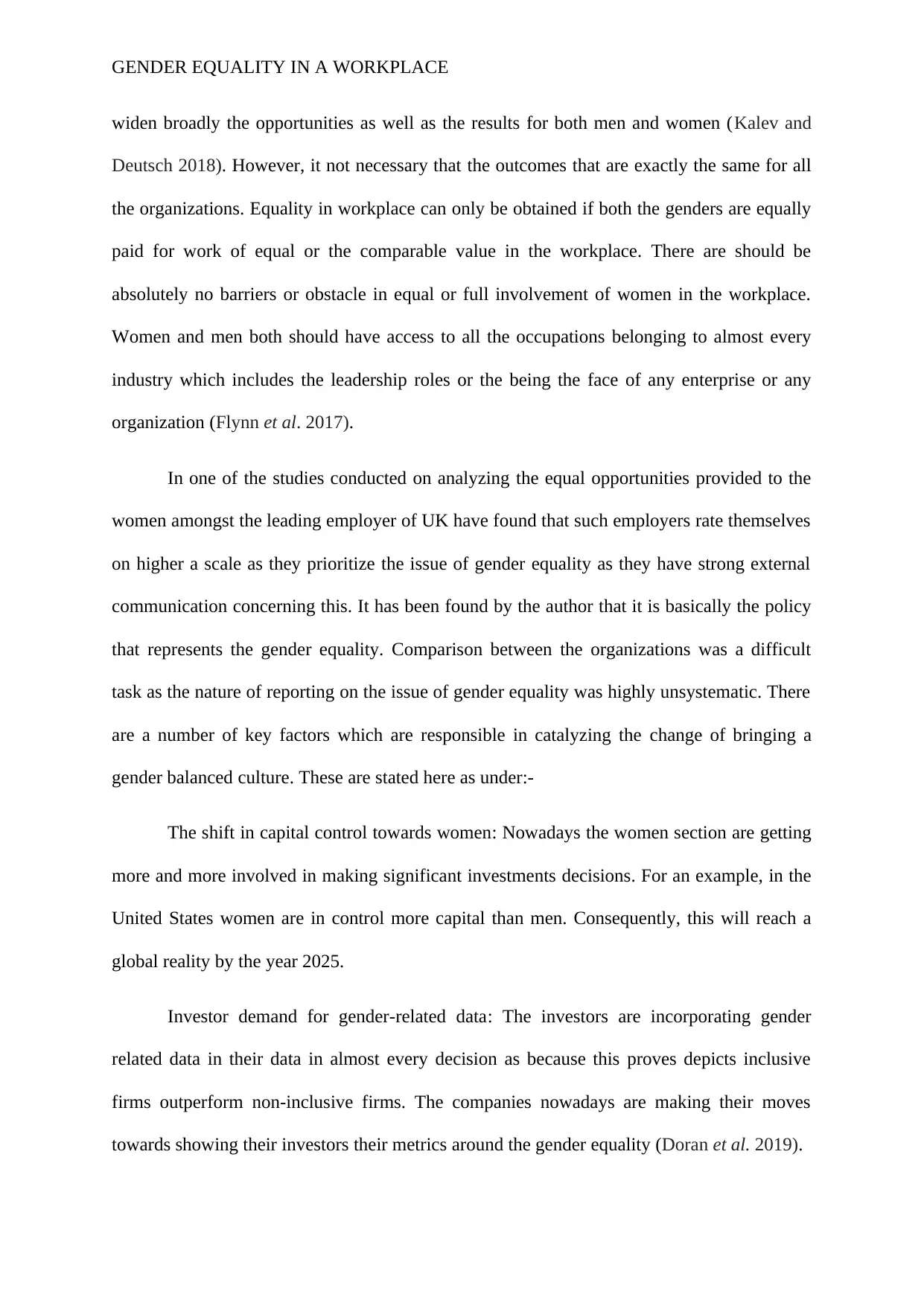
GENDER EQUALITY IN A WORKPLACE
widen broadly the opportunities as well as the results for both men and women (Kalev and
Deutsch 2018). However, it not necessary that the outcomes that are exactly the same for all
the organizations. Equality in workplace can only be obtained if both the genders are equally
paid for work of equal or the comparable value in the workplace. There are should be
absolutely no barriers or obstacle in equal or full involvement of women in the workplace.
Women and men both should have access to all the occupations belonging to almost every
industry which includes the leadership roles or the being the face of any enterprise or any
organization (Flynn et al. 2017).
In one of the studies conducted on analyzing the equal opportunities provided to the
women amongst the leading employer of UK have found that such employers rate themselves
on higher a scale as they prioritize the issue of gender equality as they have strong external
communication concerning this. It has been found by the author that it is basically the policy
that represents the gender equality. Comparison between the organizations was a difficult
task as the nature of reporting on the issue of gender equality was highly unsystematic. There
are a number of key factors which are responsible in catalyzing the change of bringing a
gender balanced culture. These are stated here as under:-
The shift in capital control towards women: Nowadays the women section are getting
more and more involved in making significant investments decisions. For an example, in the
United States women are in control more capital than men. Consequently, this will reach a
global reality by the year 2025.
Investor demand for gender-related data: The investors are incorporating gender
related data in their data in almost every decision as because this proves depicts inclusive
firms outperform non-inclusive firms. The companies nowadays are making their moves
towards showing their investors their metrics around the gender equality (Doran et al. 2019).
widen broadly the opportunities as well as the results for both men and women (Kalev and
Deutsch 2018). However, it not necessary that the outcomes that are exactly the same for all
the organizations. Equality in workplace can only be obtained if both the genders are equally
paid for work of equal or the comparable value in the workplace. There are should be
absolutely no barriers or obstacle in equal or full involvement of women in the workplace.
Women and men both should have access to all the occupations belonging to almost every
industry which includes the leadership roles or the being the face of any enterprise or any
organization (Flynn et al. 2017).
In one of the studies conducted on analyzing the equal opportunities provided to the
women amongst the leading employer of UK have found that such employers rate themselves
on higher a scale as they prioritize the issue of gender equality as they have strong external
communication concerning this. It has been found by the author that it is basically the policy
that represents the gender equality. Comparison between the organizations was a difficult
task as the nature of reporting on the issue of gender equality was highly unsystematic. There
are a number of key factors which are responsible in catalyzing the change of bringing a
gender balanced culture. These are stated here as under:-
The shift in capital control towards women: Nowadays the women section are getting
more and more involved in making significant investments decisions. For an example, in the
United States women are in control more capital than men. Consequently, this will reach a
global reality by the year 2025.
Investor demand for gender-related data: The investors are incorporating gender
related data in their data in almost every decision as because this proves depicts inclusive
firms outperform non-inclusive firms. The companies nowadays are making their moves
towards showing their investors their metrics around the gender equality (Doran et al. 2019).
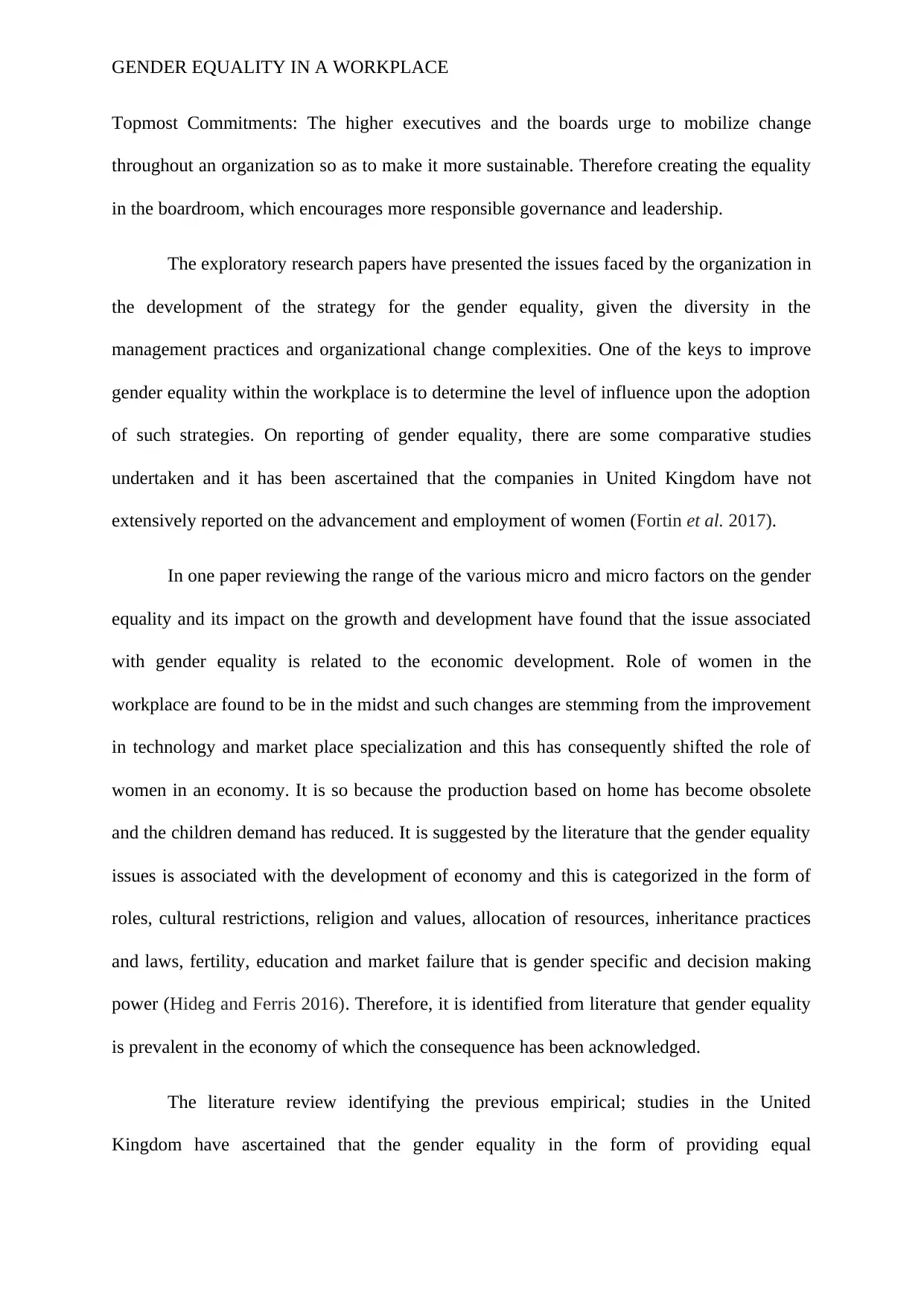
GENDER EQUALITY IN A WORKPLACE
Topmost Commitments: The higher executives and the boards urge to mobilize change
throughout an organization so as to make it more sustainable. Therefore creating the equality
in the boardroom, which encourages more responsible governance and leadership.
The exploratory research papers have presented the issues faced by the organization in
the development of the strategy for the gender equality, given the diversity in the
management practices and organizational change complexities. One of the keys to improve
gender equality within the workplace is to determine the level of influence upon the adoption
of such strategies. On reporting of gender equality, there are some comparative studies
undertaken and it has been ascertained that the companies in United Kingdom have not
extensively reported on the advancement and employment of women (Fortin et al. 2017).
In one paper reviewing the range of the various micro and micro factors on the gender
equality and its impact on the growth and development have found that the issue associated
with gender equality is related to the economic development. Role of women in the
workplace are found to be in the midst and such changes are stemming from the improvement
in technology and market place specialization and this has consequently shifted the role of
women in an economy. It is so because the production based on home has become obsolete
and the children demand has reduced. It is suggested by the literature that the gender equality
issues is associated with the development of economy and this is categorized in the form of
roles, cultural restrictions, religion and values, allocation of resources, inheritance practices
and laws, fertility, education and market failure that is gender specific and decision making
power (Hideg and Ferris 2016). Therefore, it is identified from literature that gender equality
is prevalent in the economy of which the consequence has been acknowledged.
The literature review identifying the previous empirical; studies in the United
Kingdom have ascertained that the gender equality in the form of providing equal
Topmost Commitments: The higher executives and the boards urge to mobilize change
throughout an organization so as to make it more sustainable. Therefore creating the equality
in the boardroom, which encourages more responsible governance and leadership.
The exploratory research papers have presented the issues faced by the organization in
the development of the strategy for the gender equality, given the diversity in the
management practices and organizational change complexities. One of the keys to improve
gender equality within the workplace is to determine the level of influence upon the adoption
of such strategies. On reporting of gender equality, there are some comparative studies
undertaken and it has been ascertained that the companies in United Kingdom have not
extensively reported on the advancement and employment of women (Fortin et al. 2017).
In one paper reviewing the range of the various micro and micro factors on the gender
equality and its impact on the growth and development have found that the issue associated
with gender equality is related to the economic development. Role of women in the
workplace are found to be in the midst and such changes are stemming from the improvement
in technology and market place specialization and this has consequently shifted the role of
women in an economy. It is so because the production based on home has become obsolete
and the children demand has reduced. It is suggested by the literature that the gender equality
issues is associated with the development of economy and this is categorized in the form of
roles, cultural restrictions, religion and values, allocation of resources, inheritance practices
and laws, fertility, education and market failure that is gender specific and decision making
power (Hideg and Ferris 2016). Therefore, it is identified from literature that gender equality
is prevalent in the economy of which the consequence has been acknowledged.
The literature review identifying the previous empirical; studies in the United
Kingdom have ascertained that the gender equality in the form of providing equal
⊘ This is a preview!⊘
Do you want full access?
Subscribe today to unlock all pages.

Trusted by 1+ million students worldwide
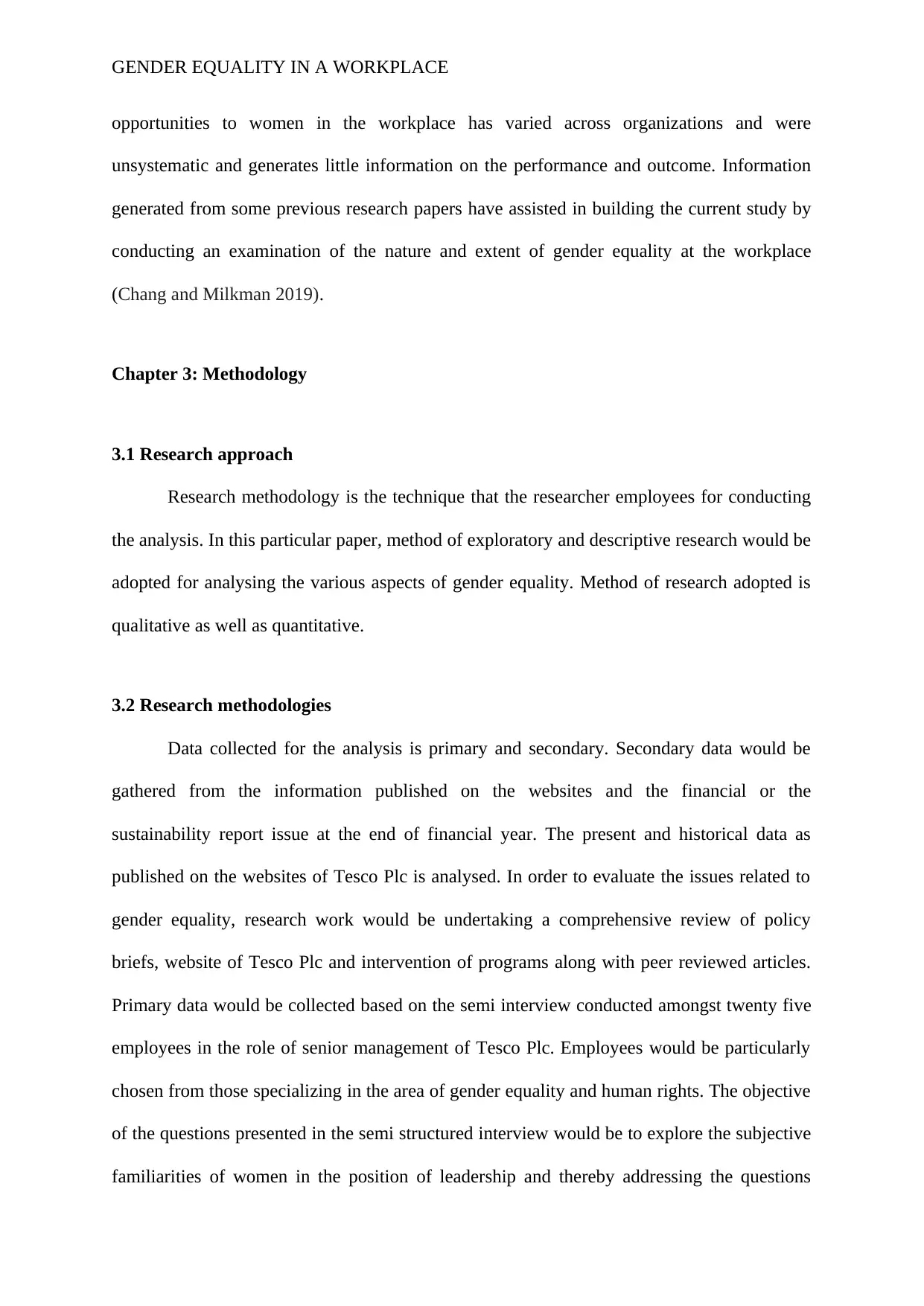
GENDER EQUALITY IN A WORKPLACE
opportunities to women in the workplace has varied across organizations and were
unsystematic and generates little information on the performance and outcome. Information
generated from some previous research papers have assisted in building the current study by
conducting an examination of the nature and extent of gender equality at the workplace
(Chang and Milkman 2019).
Chapter 3: Methodology
3.1 Research approach
Research methodology is the technique that the researcher employees for conducting
the analysis. In this particular paper, method of exploratory and descriptive research would be
adopted for analysing the various aspects of gender equality. Method of research adopted is
qualitative as well as quantitative.
3.2 Research methodologies
Data collected for the analysis is primary and secondary. Secondary data would be
gathered from the information published on the websites and the financial or the
sustainability report issue at the end of financial year. The present and historical data as
published on the websites of Tesco Plc is analysed. In order to evaluate the issues related to
gender equality, research work would be undertaking a comprehensive review of policy
briefs, website of Tesco Plc and intervention of programs along with peer reviewed articles.
Primary data would be collected based on the semi interview conducted amongst twenty five
employees in the role of senior management of Tesco Plc. Employees would be particularly
chosen from those specializing in the area of gender equality and human rights. The objective
of the questions presented in the semi structured interview would be to explore the subjective
familiarities of women in the position of leadership and thereby addressing the questions
opportunities to women in the workplace has varied across organizations and were
unsystematic and generates little information on the performance and outcome. Information
generated from some previous research papers have assisted in building the current study by
conducting an examination of the nature and extent of gender equality at the workplace
(Chang and Milkman 2019).
Chapter 3: Methodology
3.1 Research approach
Research methodology is the technique that the researcher employees for conducting
the analysis. In this particular paper, method of exploratory and descriptive research would be
adopted for analysing the various aspects of gender equality. Method of research adopted is
qualitative as well as quantitative.
3.2 Research methodologies
Data collected for the analysis is primary and secondary. Secondary data would be
gathered from the information published on the websites and the financial or the
sustainability report issue at the end of financial year. The present and historical data as
published on the websites of Tesco Plc is analysed. In order to evaluate the issues related to
gender equality, research work would be undertaking a comprehensive review of policy
briefs, website of Tesco Plc and intervention of programs along with peer reviewed articles.
Primary data would be collected based on the semi interview conducted amongst twenty five
employees in the role of senior management of Tesco Plc. Employees would be particularly
chosen from those specializing in the area of gender equality and human rights. The objective
of the questions presented in the semi structured interview would be to explore the subjective
familiarities of women in the position of leadership and thereby addressing the questions
Paraphrase This Document
Need a fresh take? Get an instant paraphrase of this document with our AI Paraphraser
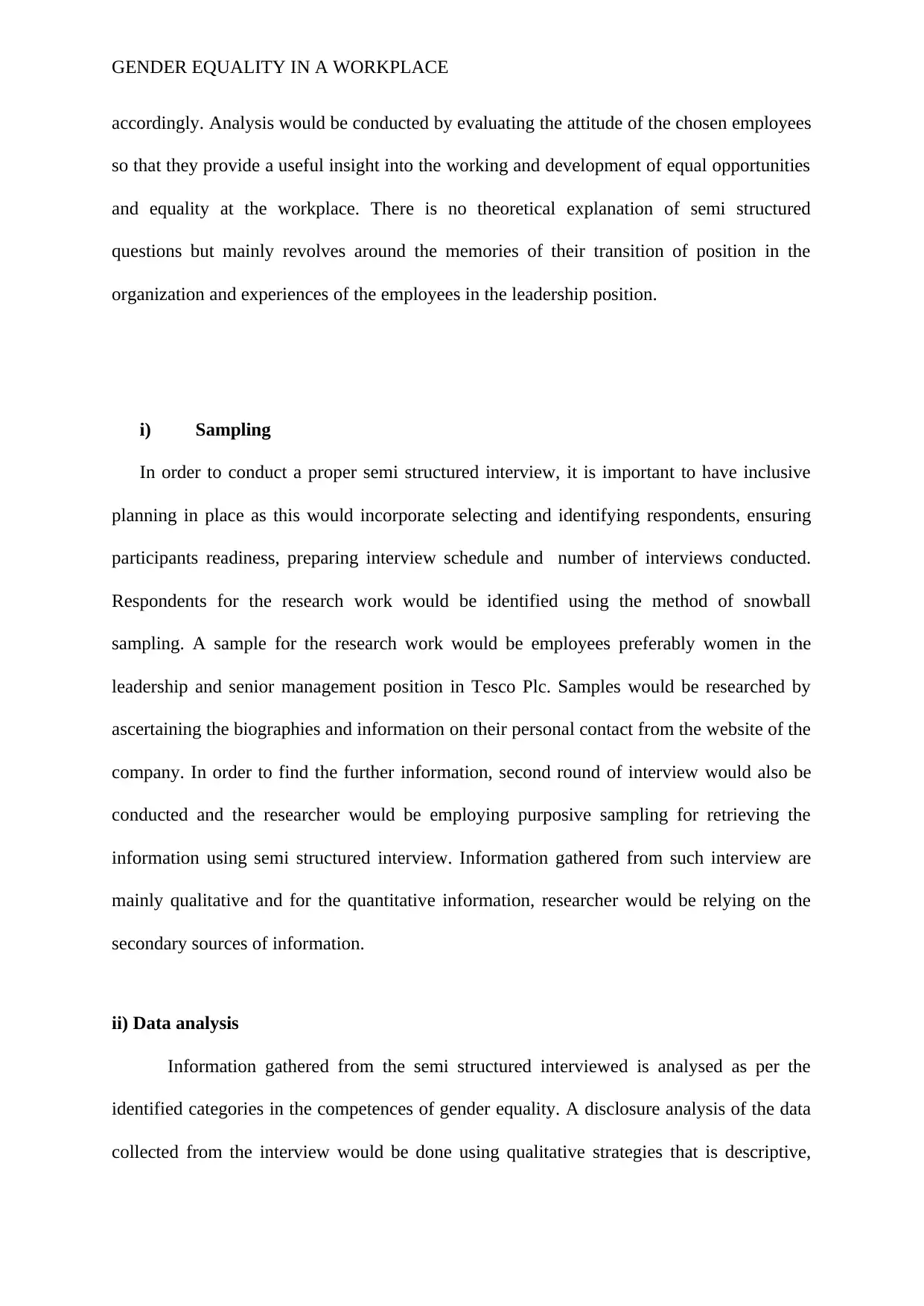
GENDER EQUALITY IN A WORKPLACE
accordingly. Analysis would be conducted by evaluating the attitude of the chosen employees
so that they provide a useful insight into the working and development of equal opportunities
and equality at the workplace. There is no theoretical explanation of semi structured
questions but mainly revolves around the memories of their transition of position in the
organization and experiences of the employees in the leadership position.
i) Sampling
In order to conduct a proper semi structured interview, it is important to have inclusive
planning in place as this would incorporate selecting and identifying respondents, ensuring
participants readiness, preparing interview schedule and number of interviews conducted.
Respondents for the research work would be identified using the method of snowball
sampling. A sample for the research work would be employees preferably women in the
leadership and senior management position in Tesco Plc. Samples would be researched by
ascertaining the biographies and information on their personal contact from the website of the
company. In order to find the further information, second round of interview would also be
conducted and the researcher would be employing purposive sampling for retrieving the
information using semi structured interview. Information gathered from such interview are
mainly qualitative and for the quantitative information, researcher would be relying on the
secondary sources of information.
ii) Data analysis
Information gathered from the semi structured interviewed is analysed as per the
identified categories in the competences of gender equality. A disclosure analysis of the data
collected from the interview would be done using qualitative strategies that is descriptive,
accordingly. Analysis would be conducted by evaluating the attitude of the chosen employees
so that they provide a useful insight into the working and development of equal opportunities
and equality at the workplace. There is no theoretical explanation of semi structured
questions but mainly revolves around the memories of their transition of position in the
organization and experiences of the employees in the leadership position.
i) Sampling
In order to conduct a proper semi structured interview, it is important to have inclusive
planning in place as this would incorporate selecting and identifying respondents, ensuring
participants readiness, preparing interview schedule and number of interviews conducted.
Respondents for the research work would be identified using the method of snowball
sampling. A sample for the research work would be employees preferably women in the
leadership and senior management position in Tesco Plc. Samples would be researched by
ascertaining the biographies and information on their personal contact from the website of the
company. In order to find the further information, second round of interview would also be
conducted and the researcher would be employing purposive sampling for retrieving the
information using semi structured interview. Information gathered from such interview are
mainly qualitative and for the quantitative information, researcher would be relying on the
secondary sources of information.
ii) Data analysis
Information gathered from the semi structured interviewed is analysed as per the
identified categories in the competences of gender equality. A disclosure analysis of the data
collected from the interview would be done using qualitative strategies that is descriptive,
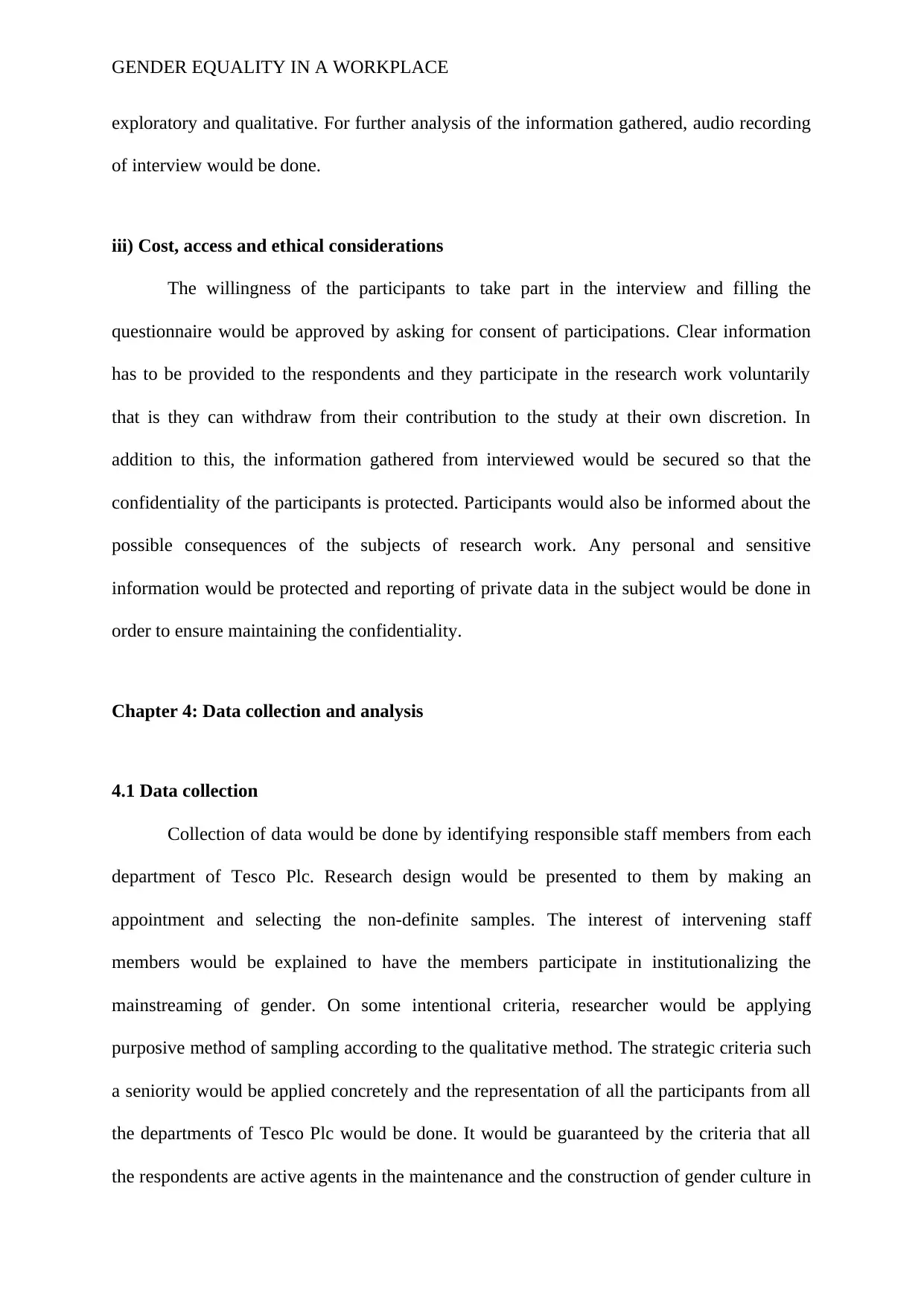
GENDER EQUALITY IN A WORKPLACE
exploratory and qualitative. For further analysis of the information gathered, audio recording
of interview would be done.
iii) Cost, access and ethical considerations
The willingness of the participants to take part in the interview and filling the
questionnaire would be approved by asking for consent of participations. Clear information
has to be provided to the respondents and they participate in the research work voluntarily
that is they can withdraw from their contribution to the study at their own discretion. In
addition to this, the information gathered from interviewed would be secured so that the
confidentiality of the participants is protected. Participants would also be informed about the
possible consequences of the subjects of research work. Any personal and sensitive
information would be protected and reporting of private data in the subject would be done in
order to ensure maintaining the confidentiality.
Chapter 4: Data collection and analysis
4.1 Data collection
Collection of data would be done by identifying responsible staff members from each
department of Tesco Plc. Research design would be presented to them by making an
appointment and selecting the non-definite samples. The interest of intervening staff
members would be explained to have the members participate in institutionalizing the
mainstreaming of gender. On some intentional criteria, researcher would be applying
purposive method of sampling according to the qualitative method. The strategic criteria such
a seniority would be applied concretely and the representation of all the participants from all
the departments of Tesco Plc would be done. It would be guaranteed by the criteria that all
the respondents are active agents in the maintenance and the construction of gender culture in
exploratory and qualitative. For further analysis of the information gathered, audio recording
of interview would be done.
iii) Cost, access and ethical considerations
The willingness of the participants to take part in the interview and filling the
questionnaire would be approved by asking for consent of participations. Clear information
has to be provided to the respondents and they participate in the research work voluntarily
that is they can withdraw from their contribution to the study at their own discretion. In
addition to this, the information gathered from interviewed would be secured so that the
confidentiality of the participants is protected. Participants would also be informed about the
possible consequences of the subjects of research work. Any personal and sensitive
information would be protected and reporting of private data in the subject would be done in
order to ensure maintaining the confidentiality.
Chapter 4: Data collection and analysis
4.1 Data collection
Collection of data would be done by identifying responsible staff members from each
department of Tesco Plc. Research design would be presented to them by making an
appointment and selecting the non-definite samples. The interest of intervening staff
members would be explained to have the members participate in institutionalizing the
mainstreaming of gender. On some intentional criteria, researcher would be applying
purposive method of sampling according to the qualitative method. The strategic criteria such
a seniority would be applied concretely and the representation of all the participants from all
the departments of Tesco Plc would be done. It would be guaranteed by the criteria that all
the respondents are active agents in the maintenance and the construction of gender culture in
⊘ This is a preview!⊘
Do you want full access?
Subscribe today to unlock all pages.

Trusted by 1+ million students worldwide
1 out of 25
Related Documents
Your All-in-One AI-Powered Toolkit for Academic Success.
+13062052269
info@desklib.com
Available 24*7 on WhatsApp / Email
![[object Object]](/_next/static/media/star-bottom.7253800d.svg)
Unlock your academic potential
Copyright © 2020–2025 A2Z Services. All Rights Reserved. Developed and managed by ZUCOL.




